What are global cities and what are their regional elements (example Tokyo)? Identife 4 models of sustainable urban development! What is meant by heterogenic and orthogenic roles of cities? What are the main aspects in the social relations and religion/culture metaphors?
Inhaltsverzeichnis (Table of Contents)
- Global cities are also regional-cities in some dimensions.
- When it comes to issues of environmental management, a city successfully integrated in the global economy might not necessarily be good for sustainable development.
- In “The cultural role of cities,” Robert Redfield and Milton B. Singer use the concept of “heterogenic” and “orthogenic” roles of the city. In Setha Low’s “Anthropology of the city” we are served with different metaphors about the city in terms of social relations, economics, urban planning and religion/culture.
- In Saskia Sassen's framework, globalization is characterised by a shift in decision-making processes from the scale of the state to that of the city. In “Globalization and the rise of city-regions,” Allen J. Scott talks about “The political order of global city-regions” (pages 820-23).
Zielsetzung und Themenschwerpunkte (Objectives and Key Themes)
This take-home exam for the Global Cities course explores the multifaceted nature of global cities, examining their regional dimensions, environmental challenges, cultural roles, and the changing political landscape within a globalized world.
- The interplay between global and regional dimensions of cities.
- The challenges of balancing global economic integration with sustainable urban development.
- The evolving roles of cities in shaping cultural identities and dynamics.
- The shifting power dynamics between cities, states, and global actors in the era of globalization.
- The role of the state in managing and governing global city-regions.
Zusammenfassung der Kapitel (Chapter Summaries)
The first question analyzes Tokyo as a global city and a regional city, highlighting its unique characteristics and its interconnectedness within national and global networks. The second question focuses on the challenges of sustainable development in global cities, examining different models of sustainable urban development and their potential to address environmental concerns.
The third question explores the contrasting perspectives of Robert Redfield and Milton B. Singer on the heterogenic and orthogenic roles of cities, alongside Setha Low's anthropological framework. The fourth question delves into the evolving political order of global city-regions, examining Allen Scott's analysis of the role of the state and its implications for development, particularly in the context of the Maputo Development Corridor.
Schlüsselwörter (Keywords)
This text revolves around key concepts including global cities, regional cities, sustainable urban development, cultural roles of cities, globalization, global city-regions, state power, and transnational regions. It explores the interplay of these themes through case studies such as Tokyo and the Maputo Development Corridor, drawing insights from influential thinkers such as Saskia Sassen, Allen J. Scott, Robert Redfield, Milton B. Singer, and Setha Low.
- Arbeit zitieren
- Antje Sigrid Kropf (Autor:in), 2010, Global cities, München, GRIN Verlag, https://www.grin.com/document/264074



